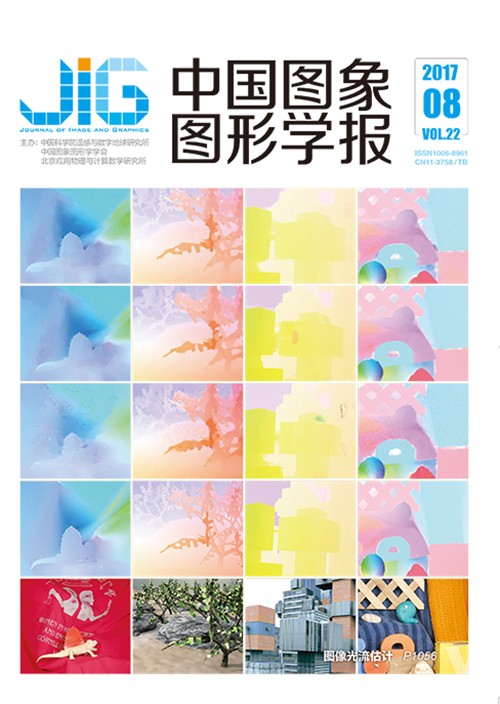
利用混合特征的多视角遥感图像配准
摘 要
目的 多视角遥感图像配准是遥感图像处理领域的一项关键技术,其目的是精确获取图像间被测区域发生的几何变换关系。由于航拍视角变化以及地物的空间分布和几何形状的复杂度,多视角遥感图像间会产生非刚性畸变问题,增加了图像配准的难度,为此本文提出一种利用遥感图像SIFT(scale-invariant feature transform)特征点阵的全局和局部几何结构特征进行多视角遥感图像配准的算法。方法 通过增加对SIFT点阵的几何结构特征描述以及利用SIFT点阵间全局与局部几何结构特征的互补关系,提升存在非刚性畸变的多视角遥感图像配准精度。 结果 实验使用谷歌地球的卫星影像数据以及无人机航拍遥感数据对本文算法进行了测试,并与3种同类算法(SIFT、SURF(speeded-up robust features)、CPD(coherent point drift))进行对比实验,本文算法在存在非刚性畸变的多视角遥感图像配准中能够有效地提升SIFT特征点阵的配准精度,从而获得更加准确的多视角遥感图像配准结果。结论 本文实现了一种结合SIFT特征点阵的全局和局部几何结构特征进行多视角遥感图像配准的算法,实验结果表明了该方法对存在非刚性畸变的多视角遥感图像能够有效地进行配准,可适用于同源多视角情况下的遥感图像配准问题。
关键词
Multi-viewpoints remote sensing images registration using mixed features
Wu Fangqing1,2, Yang Yang1,2, Pan Anning1,2, Yang Kun1,2(1.The School of Information Science and Technology, Yunnan Normal University, Kunming 650500, China;2.The Engineering Research Center of GIS Technology in Western China of Ministry of Education of China, Kunming 650500, China) Abstract
Objective Remote sensing image registration is a key technology in the field of remote sensing image processing and has been widely used in the military and civil fields, such as natural disaster damage assessment, resource census, military damage assessment, environment monitoring, and ground target identification.Remote sensing image registration is the fundamental task in image processing that aligns two or more images of the same scene (i.e., reference and sensed images), which can be multitemporal (taken at different times), multisource (derived from different sensors), and multi-view (obtained from different viewpoints).It aims to acquire the geometric transformation relationship between the reference and sensed images accurately.Non-rigid geometric distortion occurs among multi-viewpoint remote sensing images because of the changes in aerial view and the complexities of the spatial distribution and geometric shapes of terrestrial objects, especially in roads, rivers, viaduct, buildings, mountains, and other linear areas, thereby increasing the difficulty of remote sensing image registration.Few methods have attempted to solve the distortion problem in multi-viewpoint remote sensing image registration;however, most of these methods mainly focused on solving the rigid and affine geometric distortion problems.Furthermore, only single feature was applied for point correspondence estimation. Method A new multi-viewpoint remote sensing image registration algorithm is proposed to address the multi-viewpoint remote sensing image registration problem and achieve high registration accuracy.The proposed algorithm includes four steps:1) The scale-invariant feature transform (SIFT) detector is employed to extract the feature points from the reference and sensed images.Two sets of extracted feature points are considered as salient image features and are used to represent putative feature correspondences.2) Global and local mixed features are identified based on the non-rigid point set registration algorithm for registering the two aforementioned sets of SIFT feature points, which consists of an alternating two-step process (i.e., correspondence estimation and transformation update).Global and local geometric structure features are initially defined using the shape context and the local distance descriptors for measuring global and local structural differences between SIFT feature point sets, respectively.The two features are then combined to form global and local mixed features based on cost matrix.This step provides a flexible way to estimate point correspondences by minimizing global or local geometric structural differences using a linear assignment solution.An annealing scheme is designed to change the cost minimization from local to global gradually and the thin plate spline (TPS) transformation from rigid to non-rigid during registration to improve the correspondence estimation and enhance the interaction between the two steps.3) After point correspondences are calculated in Step 2, the backward approach and the TPS transformation model are applied to estimate the image transformation model between the reference and sensed images.4) After estimating the TPS transformation model, the transformed image is calculated using the TPS mapping functions that are constructed in the previous step.A bicubic interpolation algorithm is used in the sensed image on a regular grid.Each pixel from the sensed image can be directly transformed using the estimated mapping functions and the backward approach.Image interpolation occurs in the sensed image on the regular grid.Neither holes nor overlaps (due to the discretization and rounding) will occur in the output image (i.e., the transformed image) by using the backward approach.The proposed algorithm can enhance the registration accuracy for multi-viewpoint remote sensing images with non-rigid distortion by improving the geometric structure feature descriptions and utilizing the complementary relationship between the global and local geometric structure features of SIFT feature point sets. Result The main process of the proposed algorithm is implemented in Matlab, and the Jonker-Volgenant algorithm in C++ is considered as a Matlab mex function.Two series of remote sensing image data are used to evaluate the performances of the proposed algorithm.These remote sensing image data are 1) the satellite image pairs of Google Earth with different viewpoints, which contain nine image pairs taken from London, Las Vegas, Paris, Mekong River, Tokyo, Hawaii, Beijing, Niulanjiang River, and New York;and 2) aerial image pairs of unmanned aerial vehicle (UAV) with different viewpoints, which contains five image pairs taken from the Yunnan Normal University, Chenggong Campus.Moreover, the proposed algorithm is compared against three state-of-the-art methods (i.e., SIFT, speeded-up robust features, and coherent point drift.For quantitative comparisons, a reliable and fair criterion was employed to evaluate the performances of all methods.Nine pairs of corresponding points between the transformed and reference images are manually determined as ground truth, and all corresponding points were well-distributed and selected on the easily identified landmarks in the transformed and reference images.The registration error is defined as the root of mean square coordinate error among the determined corresponding points.Results show that the proposed multi-viewpoint remote sensing image registration algorithm has effectively improved the registration accuracies of SIFT feature point sets and provided accurate image registration results in multi-viewpoint remote sensing images with non-rigid distortion. Conclusion In this study, a multi-viewpoint remote sensing image registration algorithm is realized by mixing global and local geometric structure features of SIFT feature point sets.The proposed algorithm includes 1) SIFT feature extraction, 2) feature point set registration, 3) image transformation model estimation, and 4) image transformation.The main contributions of this work are shown by the successful solution of the problems of remote sensing image registration by the proposed four-step algorithm in moderate ground relief variations and imaging viewpoint changes;the algorithm also shows the best alignments in most cases compared with the three state-of-the-art methods.The experimental results on the satellite images of Google Earth and UAV images show that the proposed algorithm can accurately register multi-viewpoint remote sensing images with non-rigid distortion and is applicable to address the problems in general multi-viewpoint remote sensing image registration.
Keywords
|



 中国图象图形学报 │ 京ICP备05080539号-4 │ 本系统由
中国图象图形学报 │ 京ICP备05080539号-4 │ 本系统由